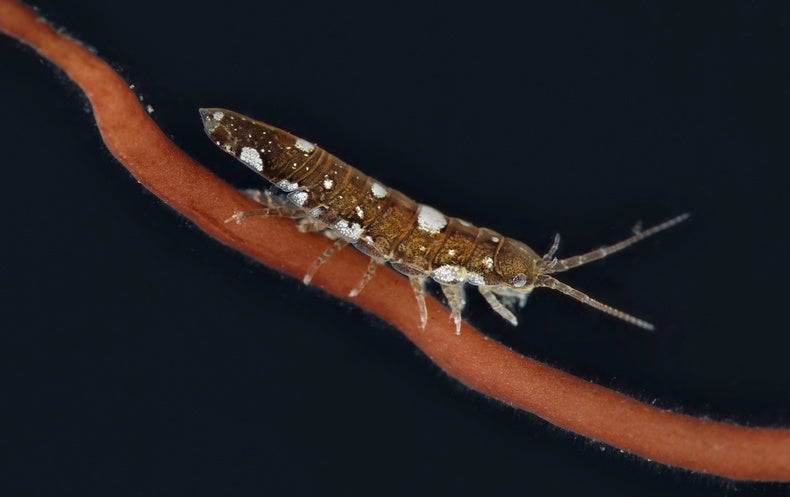Life as a single seaweed along a rocky coastline can be tough. Though there are plenty of potential partners out there, stalks of these large algae are stuck in place, and possible mates often keep their reproductive structure hidden. For the red seaweed Gracilaria gracilis, which grows in scraggly clumps, this is a particular problem. Its male gametes, or spermatia, lack flexible flagella to propel them through the water. “Without the ability to swim, the sperm needs to navigate its way to the female plants in some other way,” says Myriam Valero, an ecologist at the French National Center for Scientific Research.
Scientists have long thought that the seaweed’s spermatia simply drift wherever the current takes them, with only a slim chance of landing on a female seaweed’s reproductive organ. But in a study published on Thursday in Science, Valero and her colleagues discovered that this seaweed takes a page out of the flowering plant playbook by using a “pollinator”—in this case, the species Idotea balthica, a type of buglike crustacean called an isopod—to do the fertilization for them. This is the first recorded example of an alga practicing an aquatic equivalent to pollination.
To test the isopods’ suspected role in seaweed reproduction, Valero and her team collected stalks of Gracilaria from shorelines and dropped them into tanks meant to mimic the conditions of coastal rock pools at low tide, when the seaweeds do the bulk of their reproduction. In the first experiment, both male and female stalks were dangled in tanks with and without the isopods, which can grow to about the length of a AAA battery. To measure reproductive success, the researchers counted the number of fertilized cells, known as cystocarps, that sprouted on the female seaweeds. They observed that reproductive success was roughly 20 times higher for the seaweed stalks exposed to the isopods than it was for those in the tank without the crustaceans.
Isopods of the species Idotea balthica forage on the male Gracilaria gracilis (on the left) and female (on the right). Some are firmly gripped onto the algae, and spermatia can thus deposit on them, allowing them to fertilize the seaweed. Credit: © IRL 3614, Station Biologique de Roscoff, CNRS, SU, Roscoff, France
To ensure that the isopods themselves were responsible for the reproductive spike (instead of, say, a particularly vigorous stalk of seaweed), the researchers ran a second experiment where they dropped only female stalks into two separate tanks. One contained isopods that had previously been exposed to male seaweed; the other had no isopods. The team found that the isopods still boosted the number of fertilized cystocarps on the female seaweeds, despite the absence of nearby male stalks.
As isopods scuttle along a male seaweed stalk, they are bombarded by spermatia, which are coated in a tacky, mucuslike substance. Like a powder-coated bee spreading pollen from plant to plant, isopods spread spermatia throughout a tide pool as they travel between seaweed clumps. In exchange for their role as fertility nurses, the isopods use the seaweed for shelter and feast on a buffet of smaller algae stuck to the stalks.
This discovery is intriguing because isopods and red seaweed are fixtures of intertidal zone ecosystems around the world and have been studied for centuries, says ecologist Jeff Ollerton, a visiting professor at China’s Kunming Institute of Botany. “They’ve been known about for a very long time, but it’s only now that we understand that they actually interact with each other,” he says. Ollerton, who was not involved with the new study but provided comments and wrote an analysis of it for Science, believes the finding highlights how many complex pollinationlike interactions may be hiding in plain sight. In his own research, he has estimated that only 10 percent of the more than 300,000 known species of animal-pollinated flowering plants have had their pollinators documented.
“I suspect this is much more common in the sea than we think,” says Brigitta van Tussenbroek, a marine ecologist at the National Autonomous University of Mexico. She was not involved in the new study but found in 2016 that marine seagrass plants are pollinated by creatures such as plankton. “There’s so little information about the sexual reproduction of sea plants and algae,” van Tussenbroek says.
The new finding may have evolutionary ramifications. Scientists have long believed that animal-driven pollination originated sometime in the Mesozoic era, when flowering plants first appeared around 140 million years ago. Recent findings that some mosses and fungi also rely on animals for fertilization may bump the origin of equivalents to pollination back to the early chapters of land colonization 450 million years ago. But the discovery that pollinationlike interactions occur below the waves could push this development back still further.
Ancestors of Gracilaria bobbed in primordial pools more than a billion years ago, predating complex animals by hundreds of millions of years. Early algae likely relied on passive fertilization, but once ancestral arthropods scurried onto the scene around 550 million years ago, a mutually beneficial partnership may have been formed. “You may have this unbroken chain of interactions between animals and the precursors to plants that goes back more than 500 million years,” Ollerton says. “In that sense, it reframes how we think about pollination.”
































